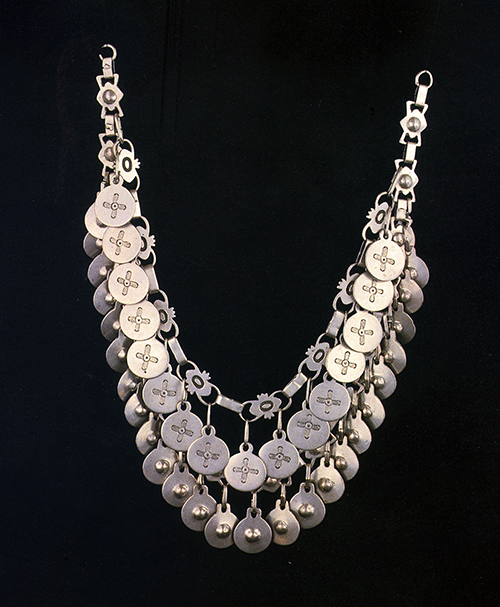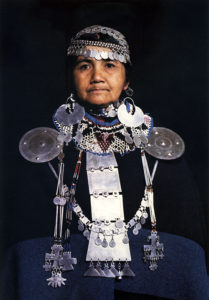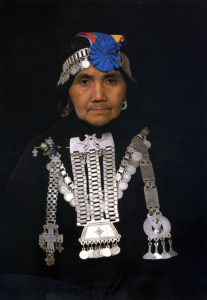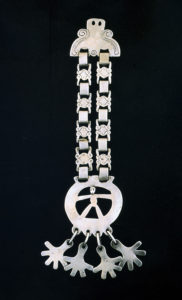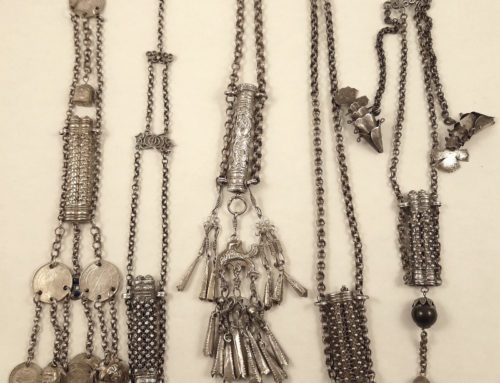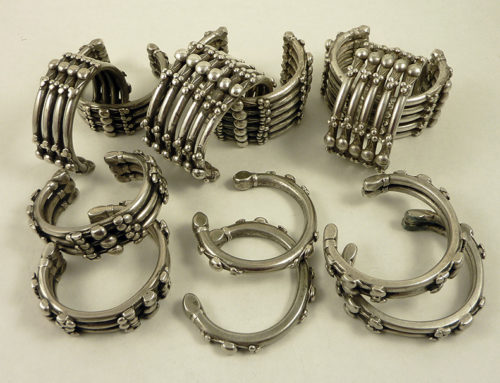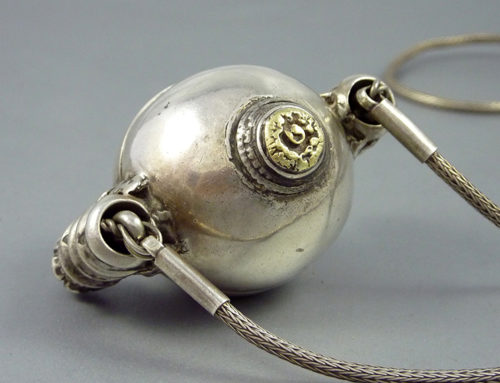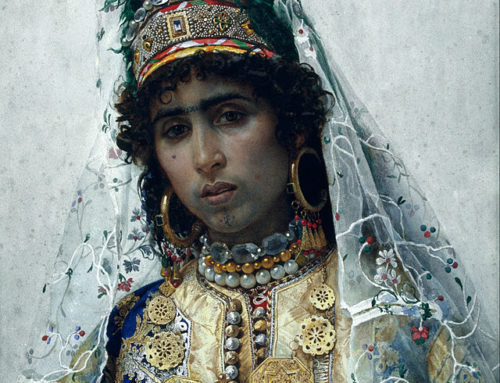 Mapuche ethnic adornment is the great unknown for lovers of ethnic jewelry. Being a silversmith work without major technical challenges, it has great aesthetic strength for the simplicity of its shapes and the great originality of its designs.
Mapuche ethnic adornment is the great unknown for lovers of ethnic jewelry. Being a silversmith work without major technical challenges, it has great aesthetic strength for the simplicity of its shapes and the great originality of its designs.
The Mapuche people live on the Andes Mountains, straddling Argentina and Chile, between the Aconcagua River and Chiloé Island. Its inhabitants are very wedded to their land and their customs, and have a rich cosmology that focuses its principles in their attachment to ancestral territories, then embodied in everyday objects such as ceramics, textiles and jewellery. It is also the people who resisted three and half centuries of conquest, first by Spanish invader, and then by the Chilean colonization.
Traditional Mapuche jewelry is made of silver, worked in basic structures of tubes, small beads, plates and chains. The combination of these elements and their engraved decoration make these jewels so peculiar.
Mapuche women have great consideration for these silver ornaments, which are worn at special and important occasions, festivals and trips to the city.Both shapes and patterns etched on the silver reproduce their esoteric connection with the land and the gods, and therefore these jewels dignify and protect Mapuche women.
Men also use silver dressings in horses decoration, habit that, in fact, comes from the Spanish, who in turn received it from the Arabs.
The origin of this silver jewellery is not prehispanic, as we might think at first, but it started with the arrival of the Spaniards. The silversmiths or retrafes reproduced in silver (brought by the Spaniards themselves) the jewels they already manufactured in copper and gold (no silver mines in this area). The techniques used previously by the retrafes were very basic, but with the Spaniards they learnt the complexity of the technique, which allowed them to bring Mapuche jewelry to its highest splendor on the second half of the nineteenth century , before it started to decay.
 The small colored glass beads were another element of exchange with the Spaniards, from which women made beautiful necklaces that were inherited from mother to daughter and which are very important when rituals and prayers are performed.
The small colored glass beads were another element of exchange with the Spaniards, from which women made beautiful necklaces that were inherited from mother to daughter and which are very important when rituals and prayers are performed.
Since the early twentieth century the Mapuche tradicional work on silver has been abandoned, and its disappearance is due to different causes. The most overriding was the loss of their lands in the early twentieth century, when the population was then placed in “reductions”, where they impoverished and emigrated. Moreover, the silver, coming to the region by Chilean silver coins that were melted, also disappeared, since currencies ceased to be made of this material.
Unfortunately the Mapuche silversmiths (called retrafes) are practically nonexistent now, and the Mapuche original jewellery that still exists and was not cast, survive in museums and private collections. There are now about 4,000 Mapuche pieces of jewellery cataloged.
Information gathered from: “Plateria Mapuche”, Von Bennewitz, Raul Morris, Editorial kactus, 1992
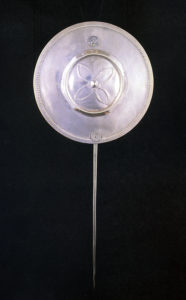 (English translation further up)
(English translation further up)
La joya étnica Mapuche es la gran desconocida para los amantes de la joya étnica. Siendo un trabajo de orfebre sin grandes desafíos técnicos, estéticamente tiene una gran fuerza por la simplicidad de sus formas y la gran originalidad de sus modelos.
Los mapuches habitan una región de los Andes, a caballo entre Argentina y Chile, entre el rio Aconcagua y la isla Chiloé. Sus pobladores están muy aferrados a su tierra y a sus costumbres, y cuentan con una rica cosmogonía que centra sus principios en su apego al territorio ancestral, plasmado después en los objetos cotidianos como la cerámica, los textiles y la joyería. Es también el pueblo que resistió tres siglos y medio a la conquista, primero del invasor español, y después a la colonización chilena.
La joya mapuche tradicional está hecha en plata, trabajada en estructuras básicas de tubos, pequeñas cuentas, planchas y cadenas. La combinación de estos elementos y su decoración grabada conforman la peculiaridad de estas joyas. Las mujeres mapuches tienen en gran consideración estos adornos de plata, que llevan en ocasiones especiales e importantes, en festivales y viajes. Tanto las formas como los motivos grabados en los adornos reproducen su vínculo esotérico con la tierra y los dioses, y por lo tanto la mujer mapuche se siente protegida y dignificada cuando lleva estas joyas.
 Los hombres también utilizan aderezos de plata en el engalanado de los caballos, costumbre que, de hecho, proviene de los españoles, que a su vez lo recibieron de los árabes.
Los hombres también utilizan aderezos de plata en el engalanado de los caballos, costumbre que, de hecho, proviene de los españoles, que a su vez lo recibieron de los árabes.
El origen de estas joyas tal y como las conocemos no es prehispánico, como se podría pensar en un primer momento, sino que, con la llegada de los españoles, los orfebres mapuches (llamados retrafes) empezaron a reproducir en plata (proporcionada por los mismos españoles) las joyas que ya fabricaban en cobre y oro (no hay minas de plata en esta zona). Parece ser que las técnicas de orfebrería usadas con anterioridad eran muy básicas, pero con los españoles aprenden la complejidad de la técnica, lo que les permite llevar la joyería mapuche a su esplendor en la segunda mitad del siglo XIX, momento a partir del cual empieza a decaer.
Las pequeñas cuentas de cristal de colores fueron otro elemento de intercambio con los españoles, con las que se realizaron bonitos collares que han pasado de madres a hijas y a los que dan mucha importancia en los rituales y rezos.
Desde principios del siglo XX se ha ido abandonando la la tradición mapuche en el trabajo de la plata, y su desaparición es debida a diferentes causas. La más decisiva fue la pérdida de sus territorios a principios del siglo XX y su reclusión en “reducciones”, con lo que la población empobreció y emigró. Por otro lado, la plata, que llegaba a la región gracias a las monedas de plata chilenas que eran fundidas, también desaparece, ya que las monedas dejan de hacerse en este material.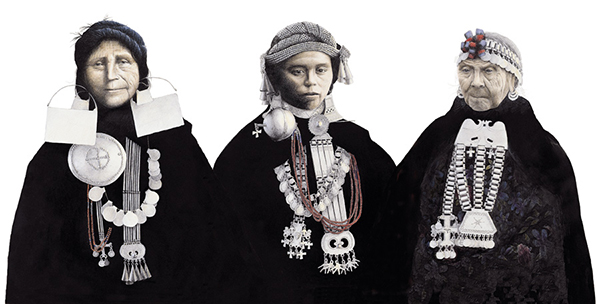
Desgraciadamente los orfebres mapuches o retrafes ya son prácticamente inexistentes, y las joyas originales mapuches que todavía existen y no fueron fundidas en su momento perviven en museos y colecciones particulares. Están catalogadas alrededor de 4.000 piezas anteriores al siglo XX.
Información recogida de: “Plateria Mapuche”, Von Bennewitz, Raul Morris, Editorial kactus, 1992

